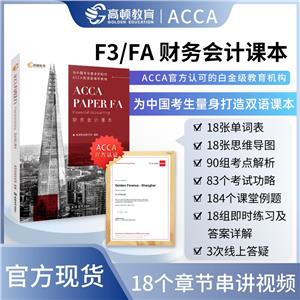Part A The context and purpose of finan reporting
Chapter l Introduction to accounting
1.1 Introduction to finan reporting
1.3 Business entities
1.4 Users and stakeh0Iders'needs
1.5 Corporate governance
1.6 Conceptual framework
1.7 Regulatory framework
Summary
Quick Quiz
Answers
Part B The use of double entry and accounting systems
Chapter 2 Sources,records and books of prime entry
2.3 Books of prime entry
Summary
Quick Quiz
Answers
Chapter 3 Ledger accounts and double entry
3.1 From books of prime entry to nominal ledger
3.2 From nominal ledger to trial balance
3.3 From trial balance to finan statements
Summary
Quick Quiz
Answers
Part C Recording transactions and events
Chapter 4 Sales tax,returns and discounts
4.1 Sales tax
4.2 Discounts
4.3 Sales and purchases
Summary
Quick Quiz
Answers
Chapter 5 Irrecoverable debts and allowances
5.1 Credit facilities
5.2 Irrecoverable(bad)debts
5.3 Doubtful debts
Summary
Quick Quiz
Answers
Chapter 6 Inventory
6.1 Definition
6.2 Measurement
Summary
Quick Quiz
Answers
Chapter 7 Tangible non—current assets
7.1 Non。cu rrent a nd cu rrent assets
7.2 IAS 1 6 Property,plant and equipment
7.3 Derecognition
7.4 Asset register
Summary
Quick Quiz
Answers
Chapter 8 Intangible non—current assets
8.1 Definition
8.2 Recog n ition
8.3 Measu rement
Summary
Quick Quiz
Answers
Chapter 9 Accruals and prepayments
9.1 Introduction(matching concept)
9.2 Expenses
9.3 Income
9.4 Effect on profit and net assets
Summa ry
Quick Quiz
Answers
Chapter 10 Provisions and contingencies
10.1 Provisions
10.2 Contingent liabilities
10.3 Contingent assets
SummaⅣ
Quick Quiz
Answers
Part D Preparing a trial balance
Chapter 11 Adjustment and correction of errors
11.1 Ylear—end adjustment
11.2 Type of errors
11.3 Correction of errors
Summary
Quick Quiz
Answers
Chapter 12 Control accounts and reconciliation
12.1 The natu re of recOnc.uation
12.2 RecOnciliatiOn within the accounting system
12.3 ReconciIiatiOn with outsider
Summary
Quick Quiz
Answers
Chapter 13 Incomplete records
13.1 Use of accounting and business equations to calculate missing figures
13.2 Use of ledger accounts to calculate missing figures
13.3 Use of cash and/or bank summaries to calculate missing figures
13.4 Use of profit percentagesto calculate missing figures
Summary
Quick Quiz
Answers
Part E Preparing basic finan statements
Chapter 14 Company accounting
14.1 Statement of profit or loss and other comprehensive income
14.2 Gains on property revaluation
14.3 Interrelationship of SOFP and SOPL&OCI
14.4 Statement of finan position
14.5 The statement of changes in equity
14.6 Notes tO the accounts
Summary
Quick Quiz
Answers
Chapter 15 Statement of cash flows
15.1 Introduction
15.2 Presentation of a statement of cash flows
Summary
Quick Quiz
Answers
Chapter 16 Events after the reporting period
16.1 Definition
16.2 Recognition and measurement
16.3 Dividends
16.4 Going concern
16.5 Disclosure
Summary
Quick Quiz
Answers
Part F Preparing simple consolidated finan
statements
Chapter 17 Introduction to consolidated finan statements
17.1 Types of investment
17.2 Parent'S separate finan statements
17.4 The consolidated statement Of financia[position
17.5 The consolidated statement of profit or loss and other comprehensive income
17.6 Accounting treatment for an associate
Summary
Quick Quiz
Answers
Part G lnprerpretation of financiai statements
Chapter 18 Interpretation of finan statements
18.1 Impoance a




















